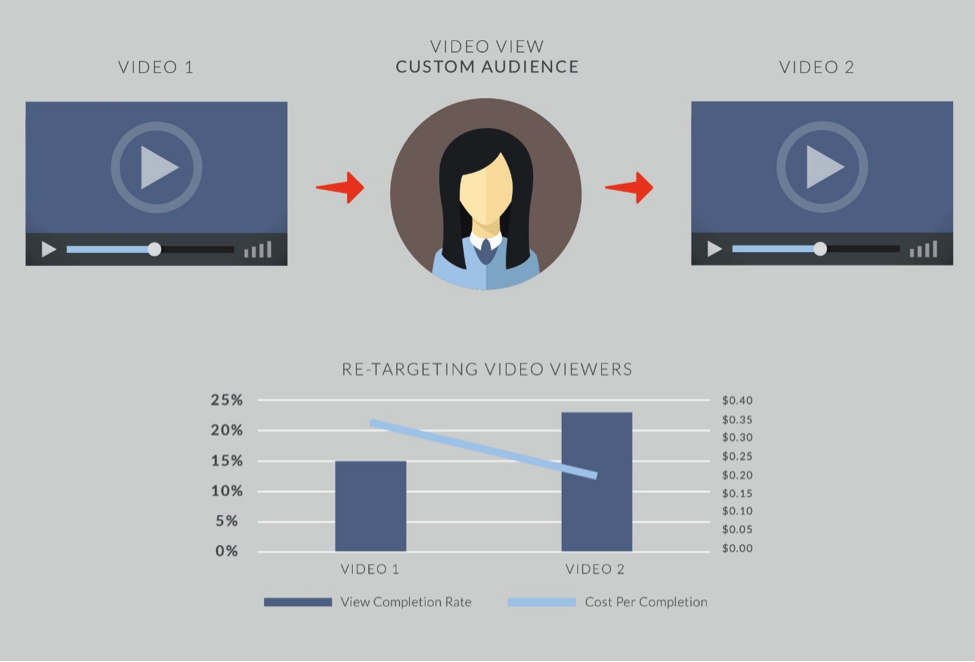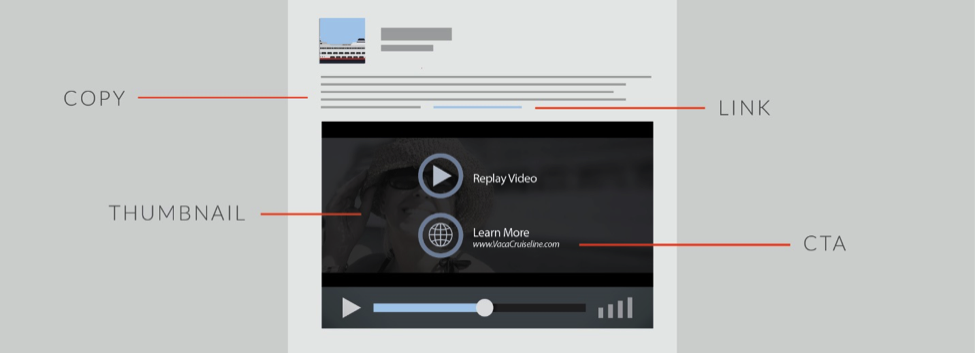Over three billion videos are watched on Facebook each day – and for good reason. Video is eye-catching, engaging and, when used properly, is a great way to bring life to a product or brand. Combine this with the wealth of targeting options available on Facebook, and advertisers have the perfect opportunity to reach the right audience with a captivating message.
So, how do you create not only a great video ad but a great video campaign?
We outline five pointers we see as essential to any great campaign, paired with examples of real videos and copy that are driving users to not just watch but click and become customers.
1. Set Clear, Measurable Objectives
Before you begin a video campaign it is essential to identify and understand your goal. Without one, you may as well be just posting a video on Facebook. Establishing a goal is step one, step two is understanding what metrics to track in order to achieve the desired end goal. Here are the common goals of video campaigns with guidelines for measurement.
Increase Brand Awareness: Track towards video views and unique reach. Remember, Facebook records a view when the user has watched for 3 or more seconds.
Introduce a New Product: Track towards completed video views. A completed video view confirms your audience has heard and seen your message and also suggests your audience is interested in the new product.
Drive Action: Track clicks to the site or on-site conversions. A link to your website can be included in the ad copy or as a CTA at the end of the video.
A clear, concrete goal will not only help you determine campaign effectiveness but also directly inform the type of content you post and who you target. Which leads us to our next step…
2. Grab Their Attention with Concise, Informative Content
With the rise of multi-tasking and the sheer volume of content vying for viewers’ attention, it’s more important than ever to generate captivating, distinctive, and emotionally powerful video content that resonates with your audience from the first frame to the last. Achieve this by sticking to a few overarching rules:
Don’t Completely Recycle Video Assets. While it may be tempting to use your video assets from a TV spot or other digital campaign, take time to evaluate if the existing content is suitable for the platform and will achieve your desired goals.
Shorter is Better. Ads under thirty seconds drive both the highest view rates and video completions. Peloton Cycle, creators of an indoor exercise bike that live streams cycling classes straight to your bike, found that their 15-second ads performed the best.
Squeezing everything you want to show and say into a brief 15 seconds is a challenge, but entirely possible.
Be Informative, Concisely. Clearly communicate your message from screen one using the starter image, ad copy or, better yet, both. The image and text should, in combination, explain what your company or product is, how it works, and why the viewer needs it.
Use subtitles or text in the video to enhance the message if it isn’t clear by visuals alone (remember, audio won’t play unless the user scrolls over the ad). Note how Peloton Cycle calls out “Live and on Demand” and “Silent Belt Drive” to communicate what can’t be shown in the video alone.
Don’t Over Rely on Autoplay. In other words, don’t let this be your excuse for not personalizing video content. Facebook’s autoplay functionality is instrumental in driving video views, but it’s still your responsibility to create engaging content.
Pick an Engaging Thumbnail. Although video ads will automatically play by default, Facebook users can disable the feature. Hedge for this by selecting a thumbnail that features your product or main message front and center.
Peloton Cycle tested multiple starter images of the bike by itself, bikers in a cycling class, and instructors, and ultimately found that images of a woman using the bike in her living room drove the most views.
This will leave you with an ad optimized for Facebook users’ viewing pleasure, ready to be placed in the Facebook news feed. But where is it most likely to get watched?
3. Go Mobile to Pinpoint Video Viewers
With video ads, the platform is the game changer when it comes to performance.
Mobile ads drive the most efficient video views – hands down – which is no surprise considering more than 65% of Facebook users watch videos on their mobile devices. In Ampush-run tests, we’ve found that mobile ads can drive nearly 60% more video completions at a 40% lower cost-per-completed view compared to desktop ads.
Capturing video views should be your initial goal, but views don’t mean anything if they aren’t driving toward your bottom line. Take these views and turn them into paying customers with retargeting with – you guessed it – more video.
4. Re-engage Viewers to Drive Additional Actions
Video is the perfect medium for increasing brand awareness and pulling new people into the funnel. But don’t let the customer journey stop there – retarget video viewers with ads that feature sequential messaging to encourage them to take the next step to become a customer.
Here’s how: Use Facebook to create Custom Audiences of people who viewed your video (3 seconds or longer), and those who completed the video. For best results, re-target users who completed the video; they represent a more engaged audience that is more likely to convert.
Video ads, link ads, and photo ads can all be used effectively for retargeting.
For example, a travel brand that partnered with Ampush saw view completions increase 50% at a 40% lower cost-per-completed view when viewers were retargeted with a second video. Similarly, Facebook found that people who were shown a video ad followed by a photo ad were 31% more likely to convert.
Regardless of the ad type, include a call-to-action that prompts users to take the next step (Learn More, Buy Now, etc.). For best results, include both a bit.ly link in the copy and a call-to-action button at the end of the video.
Your audience has seen your ad, maybe they’ve even seen it twice. Now, it’s a matter of figuring out which ads are moving viewers down the funnel and which are falling flat.
5. Test Every Variation, Measure, and Optimize
You’ve chosen your targeting and lined up a few variations of creative. Now it’s time to find out which pairing works best to achieve your goals.
Test every component of the ad in every variation that you can. This includes different edits of the video itself, the starter image for the video, copy variations, including or excluding a link in the copy, and the call-to-action at the end of the video.
As you can imagine, the number of ad variations adds up quickly, which is why bulk ad creation and testing tools, like those in Ampush’s AMP platform, come in handy.
Use the results of your multivariate tests to dictate future creative iterations and hone your targeting both on and off Facebook. You may find that the likes and interests targeting you used isn’t hitting the targeted audience, or that a preview image featuring a single product performs better than a preview image of people interacting with the product.
If you’ve followed these steps, you will now find yourself running a goal-driven campaign with ads that not only attract views but also drive qualified leads to make a transaction on your site. Can’t do that with a TV ad now, can you?
About the Author: Kelly Lammerts van Bueren is a Media Analyst at Ampush where she specializes in crafting and executing campaigns that make advertisers successful on Twitter and Facebook. Kelly has a Ph.D. in Molecular Biology from University College London and spends her time outside of work exploring California, and reading celebrity gossip.


Comments (8)